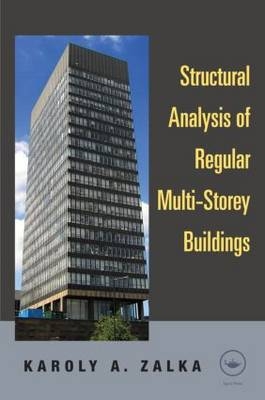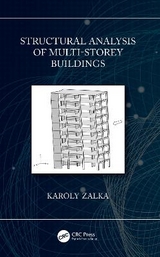
Structural Analysis of Regular Multi-Storey Buildings
CRC Press (Verlag)
978-0-415-59573-5 (ISBN)
- Titel erscheint in neuer Auflage
- Artikel merken
This guide deals with two categories of multi-storey structures. It can be used for the plane stress, stability and frequency analysis of individual bracing units such as frameworks, coupled shear walls and cores. In addition, and perhaps more importantly, it can be used for the three dimensional stress, stability and frequency analysis of whole buildings consisting of such bracing units. The closed-form solutions in the book may also prove to be useful at the preliminary design stage when quick checks are needed with different structural arrangements. Their usefulness cannot be overemphasized for checking the results of a finite element (computer-based) analysis when the input procedure involves tens of thousands of items of data and where mishandling one item of data may have catastrophic consequences.
In addition to the critical load, the fundamental frequency, the maximum stresses and the top deflection of frameworks, coupled shear walls, cores and their spatial assemblies, a very important new piece of information is the "safety factor" of the structure (either a single unit or a whole building), which also acts as the performance indicator of the structure.
MathCAD worksheets can be downloaded from the book’s accompanying website.
Karoly Zalka is a structural engineering consultant and visiting Professor at Budapest Technical University, and former consultant to the Building Research Establishment, UK. He is a Fellow of the Institution of Structural Engineers (UK) and author of Global Structural Analysis of Buildings, published by Spon in 2000.
Introduction
Part I: Theory
2 Individual Bracing Units: Frames, (Coupled) Shear Walls and Cores
2.1 Deflection Analysis of Sway-Frames under Horizontal Load
2.2 Frequency Analysis of Rigid Sway-Frames
2.3 Stability Analysis of Rigid Sway-Frames
2.4 Other Types of Framework
2.5 Coupled Shear Walls
2.6 Shear Walls
2.7 Cores
3 Deflection and Rotation Analysis of Buildings under Horizontal Load
3.1 Lateral deflection analysis of buildings under horizontal load
3.2 Torsional Analysis of Buildings under Horizontal Load
3.3 Maximum deflection
3.4 Accuracy
4 Frequency Analysis of Buildings
4.1 Lateral Vibration of a System of Frameworks, (Coupled) Shear Walls and Cores
4.2 Pure Torsional Vibration
4.3 Coupled Lateral-Torsional Vibration
4.4 Accuracy
5 Stability Analysis of Buildings
5.1 Sway Buckling of a System of Frameworks, (Coupled) Shear Walls and Cores
5.2 Sway Buckling: Special Bracing Systems
5.3 Pure Torsional Buckling
5.4 Combined Sway-Torsional Buckling
5.5 Concentrated Top Load
5.6 Accuracy
6 The Global Critical Load Ratio
Part II. Practical Application: Worked Examples
7 Individual Bracing Units
7.1 The Maximum Deflection of a Thirty-Four Storey Framework
7.2 The Fundamental Frequency of a Forty-Storey Framework
7.3 The Critical Load of a Seven-Bay, Twelve-Storey Framework
7.4 The Critical Load of an Eight-Storey Framework with Cross-Bracing
7.5 The Critical Load of Eighteen-Storey Coupled Shear Walls
8 The Maximum Rotation and Deflection of Buildings under Horizontal Load
8.1 The Maximum Deflection of a Sixteen-Storey Symmetric Cross-Wall System Building
8.2 The Maximum Deflection of a Twenty-Eight Storey Asymmetric Building Braced by Frameworks, Shear Walls and a Core
9 The Fundamental Frequency of Buildings
9.1 Thirty-Storey Doubly Symmetric Building Braced by Shear Walls and Frameworks
9.2 Six-Storey Asymmetric Building Braced by Shear Walls and Infilled Frameworks
10 The Global Critical Load of Buildings
10.1 Thirty-Storey Doubly Symmetric Building Braced by Shear Walls and Frameworks
10.2 Six-Storey Asymmetric Building Braced by a Core and an Infilled Framework
11 Global Structural Analysis of a Twenty-Two Storey Building
11.1 The Critical Load
11.2 The Fundamental Frequency
11.3 Maximum Deflection of the Building
12 The Global Critical Load Ratio: A Performance Indicator
12.1 Ten-Storey Building Braced by Two Reinforced Concrete Shear Walls and Two Steel Frameworks
12.2 Five-Storey Building Braced by a Single Core
Appendix: List of Worksheets
References
Index
| Zusatzinfo | 725; 27 Tables, black and white; 89 Illustrations, black and white |
|---|---|
| Verlagsort | London |
| Sprache | englisch |
| Maße | 152 x 229 mm |
| Gewicht | 522 g |
| Themenwelt | Technik ► Bauwesen |
| ISBN-10 | 0-415-59573-8 / 0415595738 |
| ISBN-13 | 978-0-415-59573-5 / 9780415595735 |
| Zustand | Neuware |
| Informationen gemäß Produktsicherheitsverordnung (GPSR) | |
| Haben Sie eine Frage zum Produkt? |
aus dem Bereich



